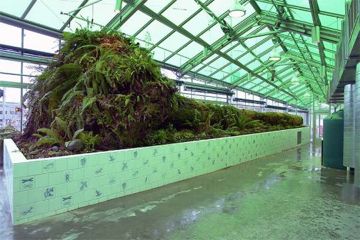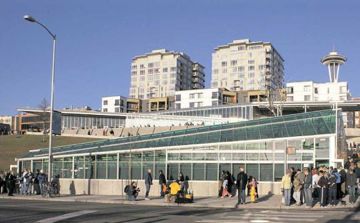This past spring at the National Art Education Association’s annual conference in Seattle, Art21 brought Mark Dion not only as a keynote speaker, but also to explore his work and consider the possibilities for interdisciplinary teaching, especially through his interactive Neukom Vivarium.
On the heels of last week’s post, I would like to share a few excerpts from a group conversation that took place last April in Seattle between Art21’s Director of Education, Jessica Hamlin and the following panel members:
- Jenn Wilson, manager of education and school programs at the Seattle Art Museum
- Kristin Jamerson, an ambassador at the Olympic Sculpture Park and one who works directly with the Neukom Vivarium helping facilitate dialogue with people who come to see the work
- Jessica Levine, a 6th grade middle school science teacher in Seattle
- Tamara Moats, an art history teacher at the Bush School in Seattle
- Mark Dion
Jessica Hamlin: We have a lot of documentation about Neukom Vivarium but it’s a very different experience to actually be in it and to think about it as a living, breathing thing. And after you make something like Neukom Vivarium, what happens when you have a really dynamic, living, breathing thing that’s both a work of art and an ecological system? What does it mean for both how we teach art, for how we think about what museum education does, for how we think about talking to other people who are not necessarily looking for art or science, but are simply interested in coming in out of the rain one day? And what does it mean as an artist to create something like this and then think about what its legacy is afterwards?
Jenn Wilson: We get to have a place like Olympic Sculpture Park that allows us to kind of push the boundaries of what an art museum conversation is into the world of environmental science, sustainability, and ecology. For me, I get to work a lot with teachers and educators to kind of push the boundaries of conversations about not only what art is but also what science is.
Jessica Levine: I come to my science education from a background in biology and environmental studies. I’m also an artist and photographer doing my work in the Seattle area. I consider the work that I do teaching about the science of sustainability and that means that thinking about sustainability as a context is more a methodology in teaching science and approaching that work, so arts integration is of course very important and the inquiry spirit of both science and art is essential. But I also come to the work in the classroom from being a wilderness educator and a landscape ecologist, so for me Neukom Vivarium is an important piece in Seattle as a place-based educator to have a space to go to within the city to experience the wilderness that is just west of here. I think my first initial connection with the piece was sort of it as a specimen and looking at the connection between small detail and large scale understanding of, in this case, sort of an ecosystem. Having the nurse log taken from a forest and brought to the city environment allows that juxtaposition to sort of come right into your face and say: What is wilderness? What is natural? What is nature? It gives us that opportunity to sort of really investigate and be in that green space to confront those questions personally. I’m particularly impressed that the piece also reveals the human aspect of natural history and so it pays homage to our natural history’s greatest with Rachel Carson’s name on the wall and others that are there. If one is to look at the log itself and then turn around to see the artists interpretations, the things on the tiles, and the curiosity cabinet that exists there, you discover that science is a human endeavor and art of course is a human endeavor and those two, both art and science, those are at the very nature of what it means to be human and that process of asking questions.
Kristin Jamerson: One of the things that I think impressed me the most when I first experienced Neukom Vivarium was the consortium of individuals that were involved in the process of creating it. Mark built a team of architects, engineers, biologists, and soil experts.
Jenn Wilson: It rarely ever reads to somebody as a work of art from the outside, initially. It very much looks like it’s a building on the structure in the park and so it’s amazing to see the reaction of them going inside and working through the process. It’s a log, but there’s a building around it. There’s tiles. That slow process of watching people discover what the work of art is: Is it just a log or is it in fact this entire encasement that was developed for the log? Is it the person who is standing in an orange vest volunteering?? I think that that’s so powerful and so important. All those little pieces have to be in place.
Jessica Hamlin: Mark, do you have like a definition? Like when you describe the Neukom Vivarium, what do you say it is? How do you define it?
Mark Dion: I say that it’s an artwork that is essentially a purpose-built green house. And every aspect of this structure is to allow this log to do what it naturally does. But you know, it’s a kind of an exercise in recontextualization. It’s a classic art strategy. It takes something from one place and puts it somewhere else and then we think about it in a very different, profoundly different way. What’s exciting about it is that it’s a work that intentionally activates all the senses. To engage with the piece is not to see it in pictures, not to see it from the outside, but to come in and feel the texture- the air is different- you know that as soon as you step through the door the smell is different, the perspective is built in this way, to kind of force a little bit of a disequilibrium in yourself. And…and the humidity, the sound, you know being inside of this building is like being in the belly of a whale, there’s a lot going on. You could feel the life support system as the…as the shutters open or as the shades go down and the vents open and the sprinklers go on. It’s constantly regulating itself like an organism. So to be in there, you feel a little bit like this thing is somehow alive. I think sometimes it is difficult to see because it is essentially a structure you know is a piece of architecture. Sometimes it’s really hard to see that the art is the thing in totality.
After looking over the transcript from this engaging and rich conversation, I also started to think about other works, and not just works of art, that encourage the kind of participation and interaction Neukom Vivarium inspires in visitors. Are there places, spaces, close enough to our classrooms that allow for engaging our students in similar ways? And if so, how can we take teaching out into those spaces to encourage broader experiences and learning?






